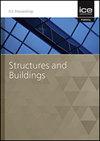利用神经网络计算不同荷载条件下钢梁的侧向抗扭能力
IF 1.4
4区 工程技术
Q3 CONSTRUCTION & BUILDING TECHNOLOGY
Proceedings of the Institution of Civil Engineers-Structures and Buildings
Pub Date : 2024-03-08
DOI:10.1680/jstbu.23.00048
引用次数: 0
摘要
侧向扭转屈曲(LTB)是钢结构因失稳而失效的一种常见模式。然而,目前的标准建议在准确确定受 LTB 影响的构件的极限承载力方面存在局限性。为解决这一问题,我们利用有限元分析(FEA)进行了一项深入的参数研究,以调查主要参数(包括各种类型的加载)对钢工字钢强度的影响。此外,还使用了人工神经网络(ANN)技术,利用生成的数据库找到了评估钢工字钢 LTB 强度的可靠程序。为了证明所开发公式的有效性,将其与使用现有公式进行的预测进行了比较。所提出的公式具有很高的准确性,是工程师设计工字钢以抵抗 LTB 的有效工具。这项研究为结构工程领域做出了重大贡献,对钢结构的创建和评估具有重要意义。本文章由计算机程序翻译,如有差异,请以英文原文为准。
Lateral torsional capacity of steel beams in different loading conditions by neural network
Lateral torsional buckling (LTB) is a common mode of failure in steel structures due to instability. However, current standard recommendations have limitations in accurately determining the ultimate capacity of members subjected to LTB. To address this issue, an in-depth parametric study using finite-element analysis (FEA) was conducted to investigate the effects of major parameters, including various types of loading, on the strength of steel I-beams. Additionally, the artificial neural network (ANN) technique was used to find a reliable procedure for assessing the LTB strength of steel I-beams using a generated database. To demonstrate the efficacy of the developed formulation, it was compared against predictions using existing equations. The presented formula demonstrated strong accuracy, making it an effective tool for engineers designing I-beams to resist LTB. This research makes significant contributions to the structural engineering field and has important implications for the creation and evaluation of steel structures.
求助全文
通过发布文献求助,成功后即可免费获取论文全文。
去求助
来源期刊
CiteScore
3.40
自引率
6.20%
发文量
61
审稿时长
12 months
期刊介绍:
Structures and Buildings publishes peer-reviewed papers on the design and construction of civil engineering structures and the applied research associated with such activities. Topics include the design, strength, durability and behaviour of structural components and systems.
Topics covered: energy conservation, people movement within and around buildings, strength and durability of steel and concrete structural components, and the behaviour of building and bridge components and systems

 求助内容:
求助内容: 应助结果提醒方式:
应助结果提醒方式:


